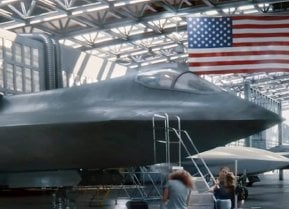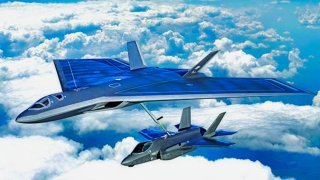NGAS: The Air Force's New Flying Stealth Tanker Could Be a Game Changer
The Northrop Grumman B-21 Raider bomber may soon have a stealthy companion in the skies: the Next Generation Air Refueling System (NGAS), also known as the KC-Z.
Summary: The Northrop Grumman B-21 Raider bomber may soon have a stealthy companion in the skies: the Next Generation Air Refueling System (NGAS), also known as the KC-Z.
NGAS Key Points and Why It Matters
-Lockheed Martin's Skunk Works recently unveiled a concept image of this stealthy aerial tanker designed for closer frontline support.
-The NGAS features lambda-style wings for stealth and strength, with engines near the fuselage. It aims to operate alongside traditional tankers like the KC-46 and KC-135, which will be phased out.
-The Air Force's Fiscal Year 2025 budget reflects this shift, focusing on developing stealthy and adaptable aircraft to address modern threats.
Meet the NGAS: The Stealthy Tanker Set to Transform Aerial Refueling
The Northrop Grumman B-21 Raider long-range strategic bomber now in development might not be the only U.S. Air Force flying wing aircraft operating in the 2030s and beyond. We're not talking about the B-2 Spirit, which will begin to be retired from service in the coming decade, but rather the NGAS, a stealthy aerial tanker.
This week, Lockheed Martin's secretive Advanced Development Programs, also known as Skunk Works, released a new concept image of the Next Generation Air Refueling System. According to The Aviationist, the aircraft is also known as the KC-Z, and once operational it could replace the KC-46 and KC-135 tankers.
In the rendering, the NGAS features lambda-style wings that offer stealth capabilities and structural strength, along with design flexibility. Its engines are positioned near the fuselage, with rounded air inlets recessed under the wing's root.
Though the NGAS appears smaller than the tankers it could eventually replace, this was just an artist's rendering – many details will likely change as development moves forward. A completely different depiction of the NGAS was released last year.
What does seem certain is that low observability is a serious consideration for the future gas station in the sky.
Multiple Tankers – Different Missions
A stealth or at least stealthy tanker could operate closer to the frontlines in a combat scenario, and thus be better positioned to support fighters and ground-attack aircraft. Meanwhile, more traditional tankers could continue to operate at a much safer distance. Such considerations are likely based on China's expanding territorial ambitions in the Indo-Pacific. The possibility of conflict with Beijing puts a far greater emphasis on aerial refueling systems, as U.S. aircraft may go to work from extreme distances.
"It's not one airplane. It's a system, so it's not one-size-fits-all. I'm not looking to develop a fleet that has to handle every threat environment," Gen. Mike Minihan, commander of Air Mobility Command, told reporters earlier this year, per Defense One.
As noted, the NGAS will be smaller and more maneuverable. But it will still be able to carry a substantial amount of fuel close to contested airspace. The larger tankers will operate farther back, ensuring that there are aerial supply lines for combat aircraft to get to a target and make it back home.
To help pay for the development of the NGAS and to get it in the air sooner, the Air Force is looking to shrink its planned purchase of tanker aircraft. In its Fiscal Year 2025 budget request, the air service will seek to divest 16 older KC-135 Stratotankers and purchase just 15 new KC-46A Pegasus tankers.
NGAL Also Coming
In addition to a new stealthy tanker, the Air Force is also looking to the future with its Next Generation Airlift program, which will develop the plane to replace the Lockheed C-130 and Boeing C-17 heavy lift aircraft.
The Air Force of the late 21st century could look quite different from that of the late 20th – and many aircraft might not even be visible on radar.
Author Experience and Expertise: Peter Suciu
Peter Suciu is a Michigan-based writer. He has contributed to more than four dozen magazines, newspapers, and websites with over 3,200 published pieces over a twenty-year career in journalism. He regularly writes about military hardware, firearms history, cybersecurity, politics, and international affairs. Peter is also a Contributing Writer for Forbes and Clearance Jobs. You can follow him on Twitter: @PeterSuciu. You can email the author: [email protected].
Image Credit: Lockheed Martin Handout Image.


